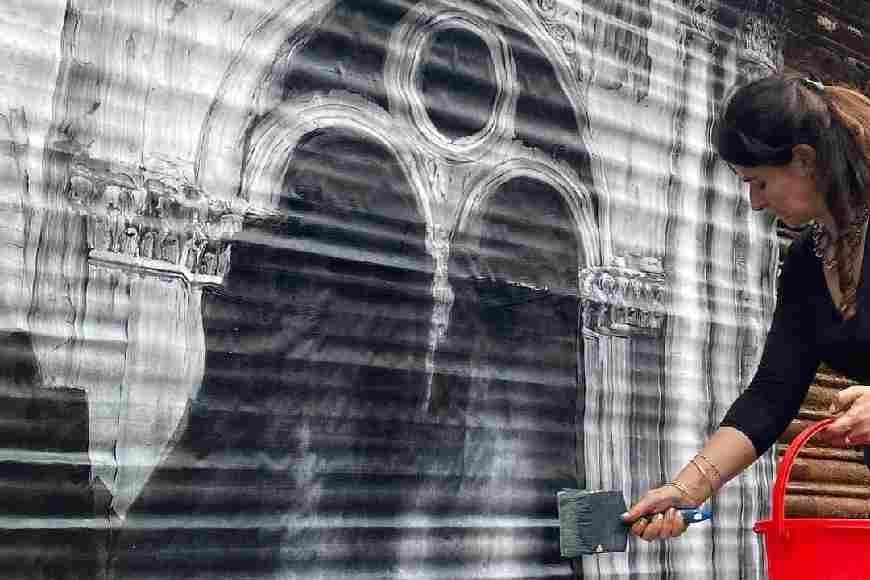French artist Annabel and husband Sourav restore old Kolkata buildings through art. Exclusive GB interview

It is a common phenomenon these days in bustling urban cities like Kolkata, to spot old buildings being taken over by land sharks who would soon destroy the heritage and history, and memories attached to them, to build apartments or malls. And this trend is increasing by the day. Every day we spot old buildings getting stripped of their heritage and their solid bold structure, in utter neglect, the ones that had stood the test of time and witnessed so many memorable and historical events. And pop comes up in their place, a totally new look, one that is low cost and faster to build, some grotesque new plush structure bereft of any old-world architectural splendour.
But there are still enthusiasts around who are trying to give a new look to the old world heritage of this city and conserve them. One such person is French artist, Annabel Schenck, who along with her husband artist Sourav Chatterjee, are trying in their own way to give a fresh look to such buildings without destroying them. On many such dilapidated houses in Sovabazar that they came across, they have pasted a piece of art on their walls ahead of the house’s demolition.

Schenck pasted an image of a colonial-style window on a wall. She chose a subject that is common to both Bengal and Marseille, her hometown. She fell in love with the heritage of Bengal, the minute she stepped into Kolkata. Annabel told GB, “I see the old houses with beautiful architecture, which hold great historical value. But they are being destroyed and pulled down randomly. They are being rebuilt in new ways so that they are cost-efficient and can be completed quickly. There should be awareness among the people to preserve the heritage buildings, the old architecture that once adorned the streets of Kolkata but has now been replaced because of little or no maintenance.”
Indeed, the architecture and the historical value connect us, the people of Bengal, in a sheer tone of nostalgia. “Earlier buildings were made over years, finishing a building took time and patience. Nowadays, houses are built in a hurry without proper thought in the architecture. Indeed, the same building cannot be preserved for a long time, but it can be renovated. In modern times, all the buildings and houses seem to have the same look and lack the grandeur of the past,” Annabel added.
“One of the images depicts the window of an old house in Kolkata. I destroyed a part of the etching (it’s a drypoint printed on Fabriano paper) with brushstrokes, which felt similar to the degradation/destruction of our heritage, and tradition and somehow a part of our culture. More broadly and symbolically, this gesture is inspired by the global phase of accelerated degradation of our environment that we are currently going through.” Annabel is talking about the Anthropocene epoch, a geological epoch when the human activity started to have a significant impact on our mother earth, it is still an unofficial unit of geologic time. “Indeed, in the order to make visible the weaknesses of a wobbly world and the principle of collapse from a plastic point of view, I have often, in my recent works, exploited the instability and degradation of architectural constructions or the collapse of heritage buildings because they are for me the symbol of the growing weakening. My work has been articulated for several years around visual thoughts on current ecological and social disorders, at the heart of an approach that can be described as ‘plastic collapsology,’ a well-known concept nowadays, which works on the issues of the possible collapse of our civilization.”
Her husband Sourav Chatterjee, a painter and an artist said, “Most of the things are no more authentic. Traditions are escaping, folk culture is deteriorating, architecture is being destroyed, and old houses getting abandoned, it is a tumultuous age altogether. Even our beloved trams of Kolkata are being uprooted in most areas. The Kolkata-ness of Kolkata is fading away among the hustle and bustle. Modernity should be embraced but not by eliminating the older structures, rather by creating new infrastructure combining both to represent both the heritage and the coming of new ideas.”
Anna’s hometown Marseille preserves its heritage but Kolkata seems to uproot itself from its origins, its joyous feeling. These wall pastings will be destroyed by the buildings, but Annabel and Sourav are not worried about it as Annabel said, “art is not lost. I can reinstall the art. I am planning to visit Kolkata again. In Kolkata, I saw trees growing on the body of the houses which look pretty but more renovation is still necessary for their betterment.”
It is ironic that we, Bengalis, have to be reminded about the value of our heritage. We should be adoring our culture and heritage more.










